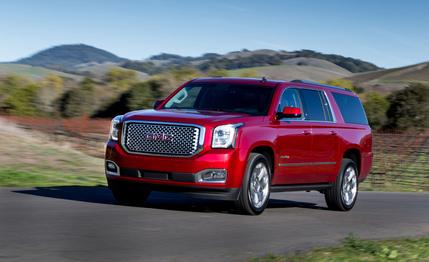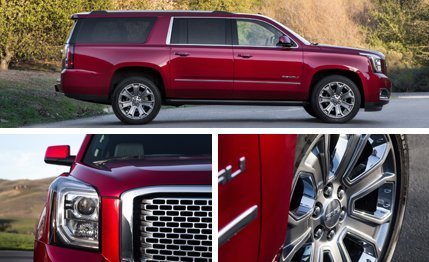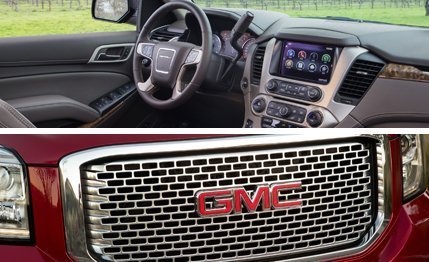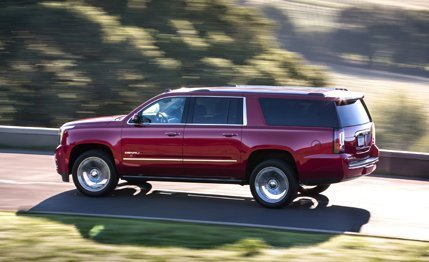
 First Drive Review
First Drive Review
You’d think that with a nicely updated Suburban going on sale, there would be little reason to consider its similarly updated Yukon XL cousin. After all, they get essentially the same mechanical and styling upgrades. But such thinking overlooks the halo of the GMC brand, as well as the magic of the Denali trim and its 6.2-liter V-8.
The only way to get that inseparable pair is from your friendly GMC store. Roughly half of Yukon and Yukon XL customers opt for the Denali version, and they’ll now enjoy a 6.2-liter V-8 freshly updated with direct fuel injection and a higher compression ratio. Generating 420 horsepower and 460 lb-ft of torque, the Denali’s substantially more powerful V-8 cuts a second and a half from the XL's zero-to-60 time, dropping it to 5.6 seconds. Not bad for a three-ton machine.
The standard Yukon XL benefits from a similarly updated 355-hp, 5.3-liter V-8, which makes it about as quick as the last-generation Denali. EPA fuel-economy estimates are up 1 mpg in the city in all powertrains, and highway ratings improve by up to 3 mpg. The towing capacity remains healthy, ranging from 7900 to 8300 pounds.


Improved performance is always welcome, but the primary reason for buying one of these jumbo machines is to haul stuff. Compared with the regular-wheelbase Yukon and Denali, the XL versions are 20.4 inches stretchier stem to stern, have an additional 26.4 cubic feet of max cargo space, and give adult third-row passengers a fighting chance at comfort, with nearly 10 more inches of legroom.
The keen buyer might be surprised that, even though the XL is slightly wider and longer than its predecessor, luggage capacity is down more than 10 percent. Blame the new flat-folding second and third rows that work with a fairly thick shelf added to the rear of the load floor to produce the flat surface. The folding seats are a great convenience, but the thickness of the shelf absorbs some volume. Wider back doors improve seat ingress and egress for all passengers in the aft section.


But the biggest upgrade is in the first row, where the benefits of the redesigned interior are most apparent. A new dash bulges and curves attractively, positions the eight-inch LCD conveniently high in the center stack, and presents logically grouped infotainment and HVAC controls. A new instrument cluster with a small central screen is attractive and legible. The Denalis get a different cluster with a much larger, reconfigurable LCD. Overall, this is a comfortable and pleasing cabin for long journeys.
The previous Yukon XL was a surprisingly comfortable cross-country cruiser, and the new version builds on that strong foundation. One of the biggest improvements is wind-noise reduction. The front side glass is now acoustically laminated, and the new doors have triple seals and are inset so their edges catch less wind. The result is an impressively hushed cabin on the highway.
As expected, the XL retains the traditional, truck-style separate body and frame construction, and both XLs have received the expected generational stiffness upgrades. This has made a firmer suspension possible for better ride control and sharper handling, although one never forgets that these machines stretch nearly 19 feet long.


The downside to this tauter demeanor is a firm ride, especially with only one or two aboard. Surprisingly, this problem is exacerbated on the Denali XL, which comes standard with magnetic-ride-control shocks. Normally, those highly responsive components—used to positive effect in the Corvette, Camaro ZL-1, CTS, and other GM products—would improve the ride-and-handling-balance equation, but the tuning in at least this truck application hasn’t yet achieved that stage of refinement.
We’d be inclined to go for the standard XL with 18-inch wheels and get all the packaging, styling, and noise-reduction upgrades with the best possible ride. But given the critical importance of bling and the added zing of the 6.2-liter V-8, we’d be willing to bet the Denalis will remain as popular as ever.